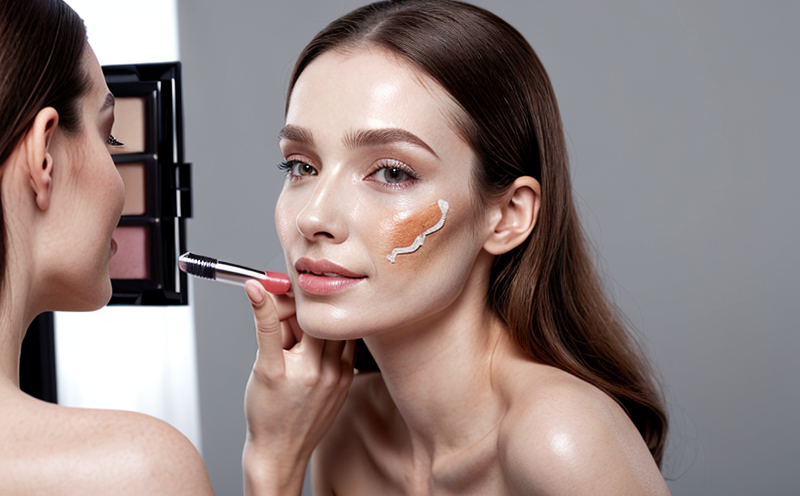Dermatological Safety Testing of Botanical Cosmetics
The dermatological safety testing of botanical cosmetics is a critical component of ensuring that products are safe and effective before they reach consumers. This process involves rigorous evaluation to identify potential irritants, allergens, or other adverse reactions in the skin. The primary goal is to safeguard public health by preventing the introduction of hazardous substances into the cosmetic market.
Botanical cosmetics often contain natural ingredients which can vary widely in chemical composition and potency. These differences necessitate thorough testing to ensure that any potential risks are identified early in the development process. Dermatological safety tests help manufacturers understand how their products interact with human skin, providing valuable information for formulation adjustments and regulatory compliance.
The testing methodology typically includes a series of in vitro and in vivo assessments aimed at detecting allergens and sensitizers, irritants, comedogenicity (potential to cause acne), cytotoxicity (cell toxicity), and photoprotection. In vitro tests use cell cultures or human skin equivalents, while in vivo studies involve live animal models or human volunteers.
For botanical ingredients, the complexity of their chemical profile requires specialized techniques such as liquid chromatography-mass spectrometry (LC-MS) for precise identification and quantification. Additionally, patch testing is often conducted to observe whether there are any adverse reactions on intact skin after application. Such detailed analyses ensure that even complex botanical mixtures undergo comprehensive scrutiny.
The regulatory landscape surrounding cosmetic safety is stringent across many countries, including the European Union (EU), United States Food and Drug Administration (FDA), and others. Compliance with these standards ensures not only legal adherence but also enhances brand reputation by demonstrating commitment to consumer safety. By partnering with reputable laboratories equipped for this type of testing, companies can navigate these regulations more effectively.
Given the growing demand for natural and organic products within the cosmetics industry, dermatological safety testing plays a pivotal role in validating that these offerings meet high standards of quality without compromising on efficacy or safety. It helps establish trust between brands and consumers by providing assurance about product integrity and reliability.
Why Choose This Test
Selecting the right laboratory for dermatological safety testing is essential to ensure accurate results that meet both regulatory requirements and company-specific needs. Here are several reasons why choosing this test can be beneficial:
- Regulatory Compliance: Ensures adherence to international standards such as ISO 10993-11, which provides guidelines for assessing the biocompatibility of materials intended to come into direct contact with skin.
- Enhanced Product Quality: Identifies potential issues early in the development process, allowing for necessary adjustments before mass production begins.
- Consumer Trust: Demonstrates a commitment to product safety, which is crucial given increasing consumer awareness of ingredient sourcing and processing methods.
- Achieving Market Entry Success: Helps overcome regulatory hurdles in different markets by providing comprehensive data on product safety.
In summary, selecting the appropriate laboratory for dermatological safety testing not only guarantees compliance with current regulations but also contributes significantly to building a strong brand image and fostering customer confidence.
Quality and Reliability Assurance
The quality of any dermatological safety test hinges on several key factors, including the expertise of personnel involved in conducting experiments, the precision of instruments used, and strict adherence to standardized protocols. Below are some measures that laboratories take to maintain high standards:
- Training and Certification: Staff undergo continuous training to stay updated with advancements in technology and methodologies.
- Instrument Calibration: Ensuring all equipment is properly calibrated ensures consistent results across multiple tests.
- Standard Operating Procedures (SOPs): SOPs provide clear instructions on how each step of the testing process should be carried out, reducing variability in outcomes.
- Inter-laboratory Comparisons: Regular comparisons between different laboratories help identify discrepancies and improve overall accuracy.
In addition to these procedural controls, regular audits and internal quality checks further enhance reliability. By implementing stringent QA measures, laboratories ensure consistent and accurate results that can be trusted by both developers and regulatory bodies alike.
Use Cases and Application Examples
| Test Case | Description | Expected Outcomes |
|---|---|---|
| Detection of Irritants | This involves identifying substances that could cause redness, swelling, or itching when applied to the skin. | Identification of irritant compounds allows for their removal from formulations. |
| Allergen Identification | The aim here is to detect allergens responsible for causing allergic contact dermatitis upon exposure. | Helps in reformulating products to avoid known allergens, thus reducing risks associated with allergic reactions. |
| Cytotoxicity Assessment | Evaluating the potential of a substance to cause cell death or damage is crucial for assessing its safety profile. | Prediction of safe concentration levels in final products based on observed cytotoxic effects. |
| Photoprotection Evaluation | Determining how well a cosmetic product protects against UV radiation helps consumers make informed choices regarding sun protection. | Inclusion of effective photoprotective agents enhances the overall efficacy of the product. |
| Comedogenicity Testing | This evaluates whether a cosmetic ingredient has the potential to clog pores, leading to acne formation. | Possible modification of formulations to minimize comedogenic effects improves user experience and satisfaction. |
These tests cover various aspects of dermatological safety, ensuring that botanical cosmetics are not only safe but also beneficial for users. Each case study highlights specific scenarios where such testing is necessary, illustrating its broad applicability across the industry.





